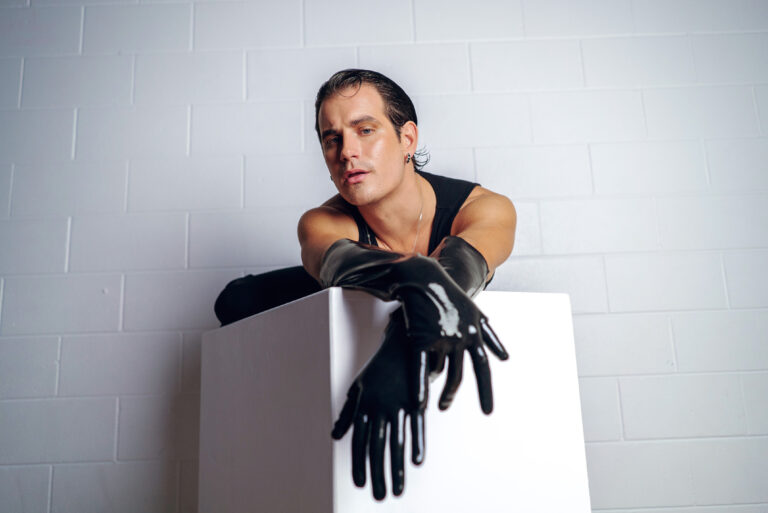The creators of butoh
Ohno (left) and
Hijikata in their
Rose-colored Dance
Butoh, or the “dance of utter darkness,” was created in the 1950s by Japanese artists Tatsumi Hijikata and Kazuo Ohno. Marked by white body makeup, shaved heads, distorted body shapes and taboo subject matter, butoh combines elements of theater, German expressionism and modern dance with facets of traditional Japanese dance forms.
Ohno, born in Hakodate, Japan, in 1906, got a late start to dance. He saw his first dance show in his early 20s but didn’t give his first concert until 1949, at the age of 43. Hijikata, 22 years his junior, studied ballet, modern, jazz and German expressionist dance in his 20s. In the 1950s, shortly after Ohno’s choreographic debut, they met studying under Takaya Eguchi (a student of Mary Wigman). They worked together to create a unique dance of intensely controlled physicality and theatrical transformation, which Hijikata named butoh.
Ohno and Hijikata mostly choreographed separately, and their choreographic styles were very different. Ohno adopted an androgynous persona onstage, dressing in both male and female costumes, to highlight transformation and mask his own identity. Hijikata had a darker approach, embracing the grotesque, provocative and violent. His pieces were often shocking and disturbing and even got him banned by the Japanese Dance Association early in his career. Despite their differences, both used exaggerated facial expressions, a hunched spine and gnarled hand gestures—characteristics that now distinguish butoh.
Hijikata stopped dancing in 1973 but continued to direct and choreograph on Ohno and others until his death in 1986. Ohno performed butoh works in theaters, hospitals and outside venues throughout the 1960s, ’70s and ’80s. He opened the Kazuo Ohno Dance Studio, dancing well into his 90s until his death in 2010. His son, Yoshito Ohno, took over his studio and continues to teach butoh workshops today. DT
Kazuo Ohno (background) and his son, Yoshito, in Requiem for the 20th Century
Fun Facts
*Near his death in 1986, Hijikata sat up in his hospital bed and performed his last dance for those attending him.
*Ohno loved Western culture and used Argentine tango music, Chopin, Bach, Elvis Presley and Pink Floyd in his work.
The Work
Kinjiki (Forbidden Colors) (1959) Considered highly shocking, this duet of Hijikata’s—one of his first butoh pieces—was for himself and Ohno’s son, Yoshito. It explores themes of violence and sexuality.
Rose-colored Dance (1965) For this duet, Hijikata and Ohno wore long, white dresses to appear androgynous and mixed pedestrian gestures, like an embrace, with traditional Western dance, like arabesques.
La Argentina Sho (Admiring La Argentina) (1977) In this hour-long solo (considered his masterpiece), Ohno transforms into many different characters, from female to male and back again, in homage to Antonia Mercé, a Spanish dancer.
The Legacy Lives On
Kazuo Ohno’s son, Yoshito Ohno, and several students of Hijikata and Ohno continue to perform and teach butoh around the world today, including Ko Murobushi, who co-founded the all-female butoh company Ariadone with Carlotta Ikeda. At age 68, Murobushi is considered the leading disciple of Hijikata’s choreographic vision. Additionally, the husband and wife duo Eiko & Koma, who studied with Ohno, create and perform works influenced by butoh throughout the U.S. In October, Eiko performed a solo installation work, A Body in a Station, in the Philadelphia Amtrak station. Annually, butoh practitioners gather at several festivals, including the Moving Bodies Butoh Festival in Dublin, Ireland, the Asheville Butoh Festival in Asheville, North Carolina, and the Seattle Butoh Festival.
Resources:
Print:
Butoh: Metamorphic Dance and Global Alchemy, by Sondra Fraleigh, University of Illinois Press, 2010.
Hijikata Tatsumi and Butoh: Dancing in a Pool of Gray Grits, by Bruce Baird, Palgrave Macmillan Press, 2012.
No Fixed Points: Dance in the Twentieth Century, by Nancy Reynolds and Malcolm McCormick, Yale University Press, 2003.
WEB:
Kazuo Ohno Dance Studio
kazuoohnodancestudio.com
Photo (top) by Tadao Nakatani, courtesy of Kazuo Ohno Dance Studio; by William W. Irwin, courtesy of Dance Magazine archives



